Japan's Real First Console? Bandai's TV Jack 5000
The Epoch Cassette Vision is often reported as the first Japanese cartridge-based game console. But reality is always a bit more complicated. In 1978, years before the Cassette Vision, two Japanese companies put together cartridge-based game consoles that were unique to Japan, but relied on technology and chips licensed from American firms. And hey, despite my whirlwind tour of Pong consoles, I never looked at GI chips.
Who is Jack
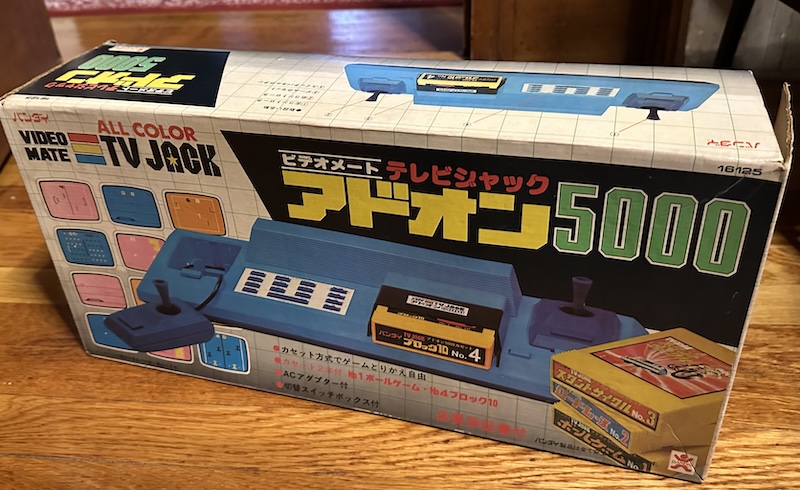
Behold, the *breathes in* Bandai Video Mate All Color TV Jack Addon 5000. (longest console name in the history of the blog?) This 1978 console was the follow-on to Bandai’s earlier Video Mate TV Jack consoles, which were more or less the same as everyone else’s Pong-on-a-chip consoles. (The TV Jack 2500 appears rather intriguing, but we’re not looking at that one today)
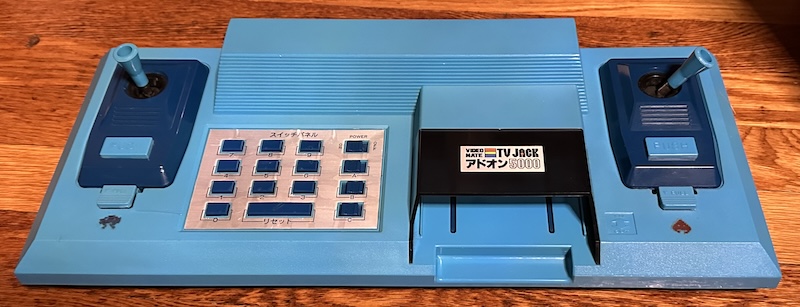
The TV Jack 5000 is at least a fairly good-looking system, especially in blue. Note that the little Space Invaders-style stickers near the detachable wired controllers were not stock, and were added by a previous owner of this console. The joysticks are, quite frankly, terrible. No self-centering, lightweight and far too easy to move around. But they are proper analog controls. Joysticks at least promise two-dimensional motion rather than a one-dimensional paddle.
But let’s face it. The thing that makes the TV Jack 5000 interesting isn’t the controllers. It’s these: the cartridges.
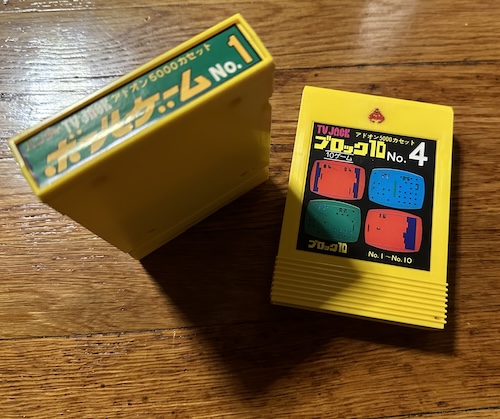
I can definitely see why some people thought this might be a Fairchild Channel F cousin, with these banana yellow cartridges with a nice spring-loaded shield at the bottom. But they are very much not the same as the Channel F. Let’s dig in.
Teardown
Most of that blue box is empty. See the control pad, with its array of buttons and switches? That’s the only area that the PCB is actually connected to.
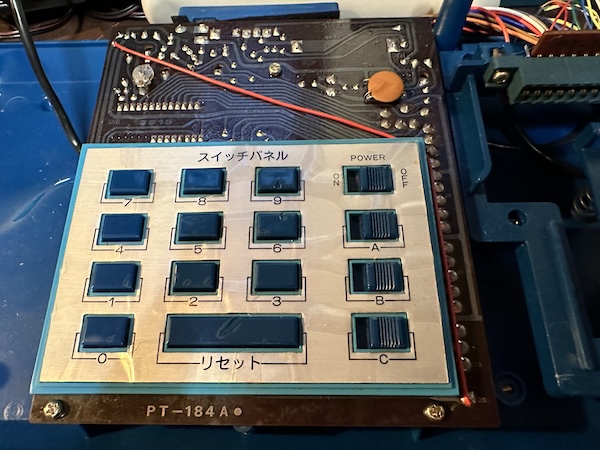
All of the controllers are directly wired into the cartridge slot, bypassing this PCB entirely. Also, the presence of hardwired cables inside the box means that the inside is prone to melting from the plasticizers; this is pretty much entirely unavoidable with the design of this console. I can’t imagine Bandai thought anyone would care nearly fifty years later.
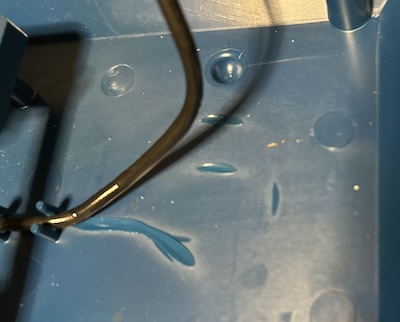
As for that PCB, it’s even more bare on the other side. There’s nothing behind that button grid, just in the area at the top. And there’s only one IC outside of the (actually shielded) RF box: the General Instrument AY-3-8615.
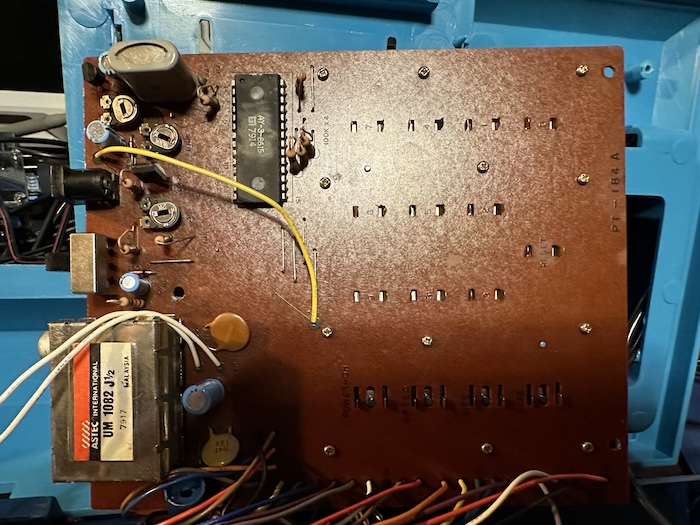
Interestingly, this is actually more than the Cassette Vision (excluding the controllers), though it might not look it. The Cassette Vision didn’t use an RF box, so its RF components are all spread throughout the PCB. But all its IC does is take in the kind-of component-ish video output of the µPD777 from the cartridge and output the RF-modulated composite video. What’s the AY-3-8615?
AY-3: Not just a sound chip
In the past, I’ve briefly talked about the AY-3-8500, General Instrument’s first Pong-on-a-chip. One interesting characteristic of this chip is that it outputs the composite video signal on a whole bunch of pins, each with different parts of the signal. An implementer, like here is Magnavox on their Odyssey 300, has to combine them somehow.
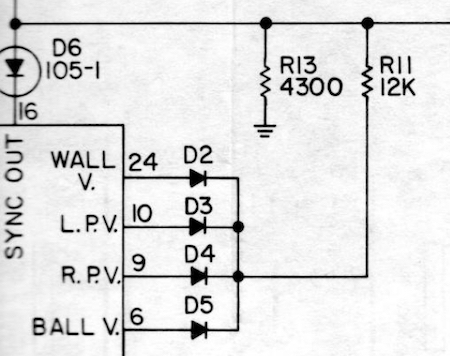
This was done because while the Magnavox Odyssey 300 was monochrome, General Instrument also sold the AY-3-8515, a “Ball & Paddle Color Converter”, which took in all of those separate signals, and modulated them with different colors. (This is entirely composite video, so it’s using different phases of an input colorburst crystal)
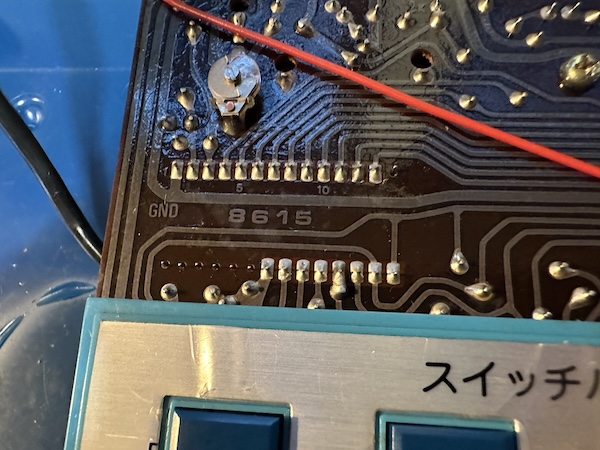
AY-3-8615 probably sounds similar to AY-3-8515. And while making assumptions like that on chip numbers is not always safe, it is here: the AY-3-8615 is a “Superstar Color Converter”. Check out the GI GIMINI parts catalog for the details. The 8600 series was GI’s successor to the 8500 series, so we’re in the fancy second generation of Pong consoles now.

You might wonder what the “select” and “strobe” inputs and outputs are about. These are the game select buttons; they’re matrixed. Between them and the hue adjust value, different Pong consoles using the AY-3-8615 could provide different colors for their system.
If we crack open a cartridge for the TV Jack 5000, this is what we see. (And here’s the back, if you want to trace out the pinout)

It’s only the monochrome game chip inside. All the color comes from the AY-3-8615 in the console; since it’s compatible with all of the AY-3-8600 series, it’s able to colorize any one of those. So while it’s light-years away from ROM-based consoles, this is still less of a generic “all the logic on the console” system than the Cassette Vision.
And in case you were worried Bandai did anything original here, scroll down to page 49 of the GI GIMINI catalog, “GIMINI Economy ‘8600’ Programmable Game Set’. This is more or less exactly what the TV Jack 5000 is. That’s why it uses a self-contained RF modulator; Bandai followed a stock design from a US company, where self-contained RF modulators were the norm, rather than the Japanese market where the extra shielding wasn’t required.
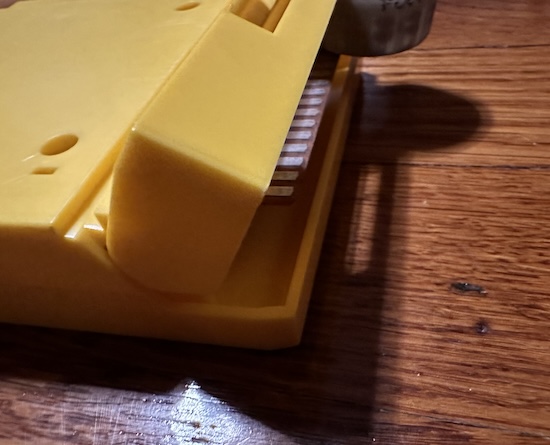
That cool spring-loaded cartridge design is all Bandai, though. I suspect you’d need a pin adapter to use a European PC-50x game cart on the TV Jack 5000, but other than that I don’t think it’d be that hard. Bandai handled the parts they were good at: the toy-like plastic enclosure. You know, the things you actually touch.
Getting a video output
I had some trouble with this on my usual RF box, which isn’t surprising since long-time readers know that that box is terrible, and the Japanese standard analog channel 1 and 2 are taken up by FM radio stations in my region that interfere. So I decided to try something a bit more vintage.
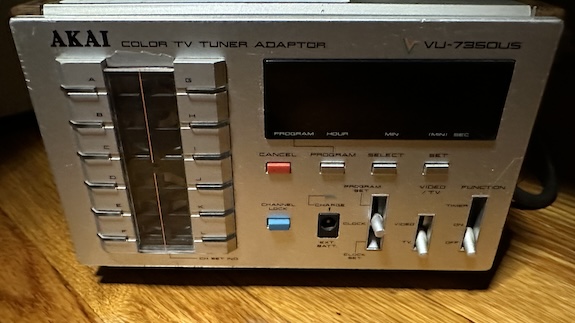
Behold, the Akai Color TV Tuner VU-735OUS. I was hoping that this would work better than the modern digital tuner, because its analog parts would allow clearer adjusting of the tuner. It’s very likely the old TV Jack 5000’s aging components no longer tune to exactly 91.25MHz, so a little analog adjustment might help.
But I got this:

Clearly a picture signal, but also something has gone seriously wrong with the sync timing. I’m not sure if this is because the Akai is failing and needs a recap, or the TV Jack is failing and needs a recap. For now I’ll put it aside, because SlyDC on the AtariAge forums happened to note that the TV Jack 5000 can be very easily composite modded, without need for a circuit at all.
So this always feels a little dirty to just wire up a little tail directly to the RF modulator input, but with the system not having an easy 5V for my amplifier chip, it seemed like it was worth a try. On the PCB, the video signal is labeled “V”.
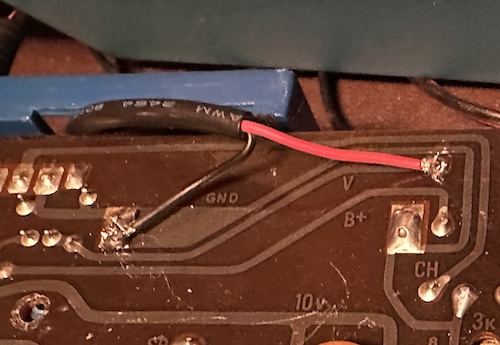
Games
Bandai only released four cartridges for the system, even though General Instrument offered seven “superstar” games. The three they excluded were “Superspace”, a Computer Space-type game, “Submarine”, a shooter between a submarine and a destroyer, and “Rifle”, a lightgun game, as Bandai left off the gun port.
Of the four, I have two. And they’re probably the less interesting two. Like all the games in the GI 8600 “Superstar” series, they’re in the category I called “digital Pong”, games put together of counters and hardwired logic, without a microcontroller or CPU governing things as in the Cassette Vision and RCA Studio II.
No. 1: Ball Game
No. 1 Ball Game is Bandai’s branding of the AY-3-8610-1 “Superstar” chip. This is the advanced General Instrument Pong-on-a-chip, so the gameplay is basically identical to every single AY-3-8610 console. Go to the Pong-Story rarity list and search AY-3-8610. There’s a lot. (I guess being NTSC makes it a little more rare?)

This is the more advanced version of the AY-3-8500 Pong-on-a-chip. As you might have guessed from the joysticks the TV Jack 5000 features, many feature two-dimensional motion, meaning the General Instrument crowd finally caught up to Magnavox. (They were all paying for their patent rights, after all)
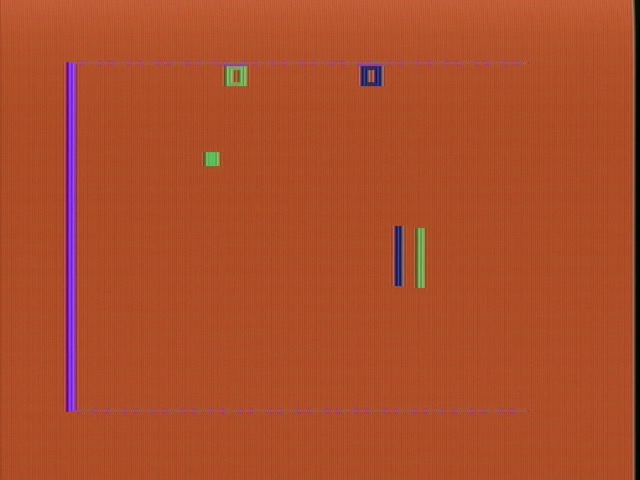
Some of these games are a bit more sophisticated than their counterpart. Hockey now features adorable little goals. Notice that in the games where you have two paddles on each side, one is fixed horizontally and only follows the vertical motion (representing the goalie, I suppose) and the other can move both horizontally and vertically. In some games like Pong, your paddle can not cross the center line.
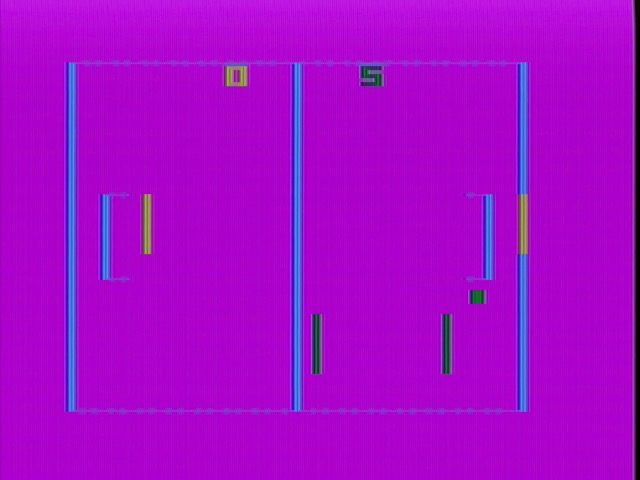
Prefer the old-style gap in the border? Don’t worry, Soccer has got you covered.

And sure, there’s also a Basketball-like game (which is about as confusing as the Atari Breakout inspired one, but now has vertical paddles) and a bunch of one-player variants. But for my money, the most interesting of the bunch is Gridball, a reverse Pong game.
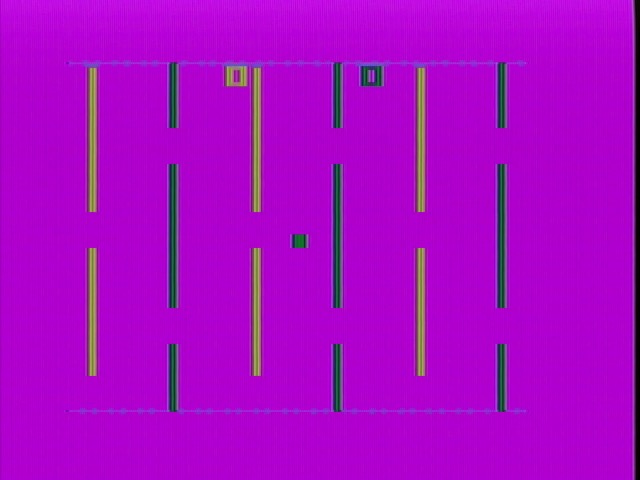
There are also a two target shooting games. Unlike on the AY-3-8500, these are not lightgun titles. Instead, you use your joystick to control pointers and then press the fire button. One-player and two-player modes exist. It’s interesting enough and works better than the strange Nintendo “Shooting Game”, but isn’t necessary now that we have the Atari 2600 version of Crossbow.

Because the AY-3-8610 was so widely used, this is the most accessible set of games. Like, seriously, any of them will do; if they don’t have the AY-3-8615, it’ll just be in monochrome. (And if it uses the AY-3-8600 instead, it won’t have the target shooting games) On PC-50x consoles, this seems to be frequently branded “Supersport”.
No. 4: Block 10
This is Bandai’s branding of the AY-3-8606-1 game, which GI branded “Wipeout”. Honestly, I could’ve included this title in my “Breakout Battle” post, because this is in fact a Breakout clone. Or a cousin at least– this one’s 10 variations are a little more unique, at least.

That’s right, Block 10 is a horizontal rendition of the game, much like Steve Wozniak’s Little Brick Out on the Apple ][. I’m not sure why this isn’t more common for rendering Breakout on a horizontal monitor, honestly. Pretty much all the game modes here would be better with a paddle, as they don’t have two-dimensional motion, but you can’t always get what you want.
What you can get is this neat two-player battle Breakout with walls on either side. The goal is to break through your opponents barrier without letting them break through yours. I guess this is just Pong on easy mode, but it’s pretty cool regardless.
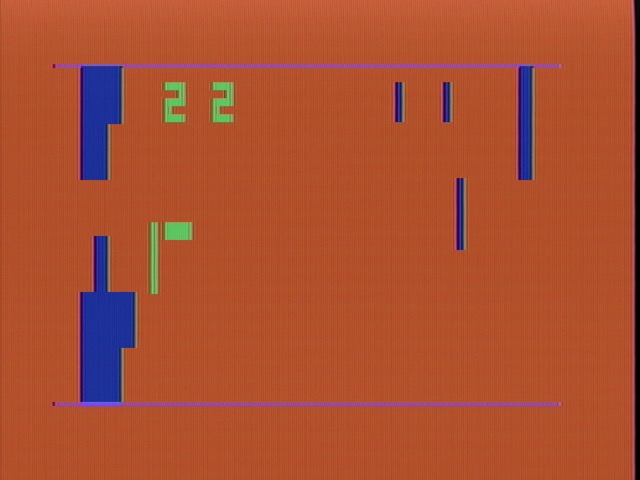
The bulk of the ten game modes, though, are variations of this Breakthru-like game. The ball passes through these dots without stopping. In the below mode, the goal is to collect all the dots of your color before your opponent can collect their dots. The ball changes to the color of your paddle after it bounces off of it, and you can only collect dots if your color ball passes over your color dots.
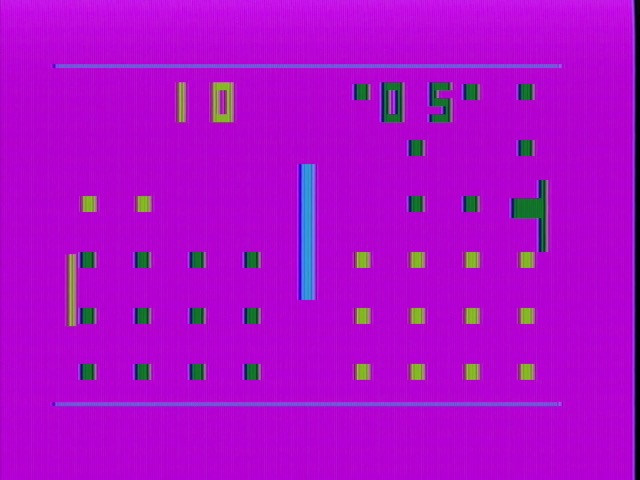
This particular mode, where there’s a line in the middle that you have to bounce around, is honestly more trouble than it’s worth when it gets to the latter ones. Bouncing the ball to the far targets is a pain. There are a few other equivalent modes, including one-player, and modes without the line and where both sides compete to collect the same dots, and those are more fun.
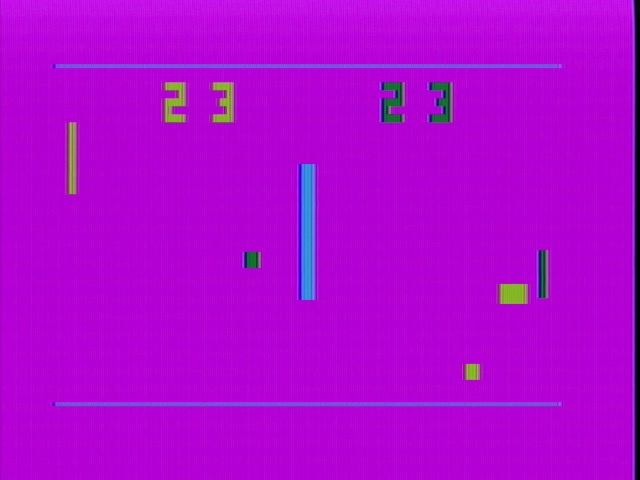
One thing you might notice is that the color selections are pretty similar to the other game. But this should make perfect sense: the color chip is shared for all games on the TV Jack 5000, so you’ll get the same color palettes for games that have the same button mapping.
What about the other two games?
- No. 2. Road Race - A variant of the Highway-type game, also seen on RCA Studio II, but with two roads for two players side-by-side. Actual car sprites! GI calls this “Road Race”, and the chip the AY-3-8603. Apparently this also has some more sophisticated road sounds rather than just the beeps.
- No. 3 Stunt Cycle - GI just calls this game “Cycle”. The GIMINI catalog I have calls this the AY-3-8765, but there’s also another variant of this chip, the AY-3-8760, floating around: I don’t know what the difference is, but presumably the 8765 is later because the number is bigger. This one’s a clone of the Atari game Stunt Cycle, and it’s good enough at that that Atari used it in their own home Stunt Cycle console. (Sold as Motocross at participating Sears retailers)
Jack is here
The TV Jack 5000 does not usually get the credit as the first Japanese cartridge-based console, likely because of its massive technical dependence on General Instrument chips. It’s probably one of the nicest PC-50x-type consoles for the American audience, though, since it’s NTSC. If I can find an AY-3-8750-1 chip somehow, it might be nice to create a forbidden Superspace cartridge.
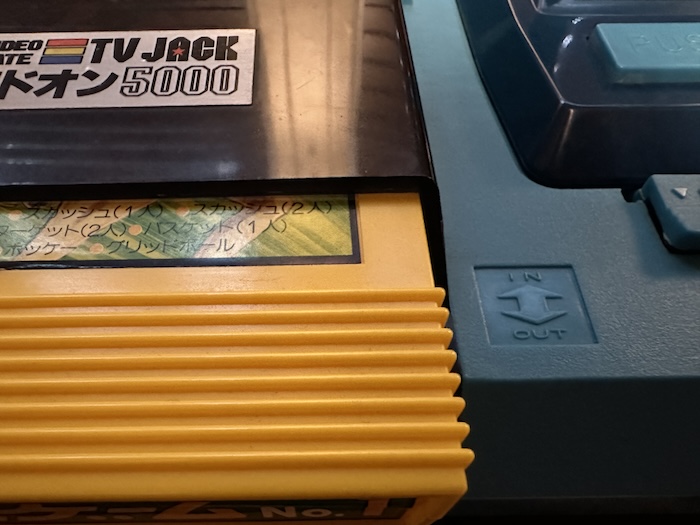
In general, I find the AY-3-8615 console concept (PC-50x, TV Jack 5000, whatever you want to call it) very interesting. It’s a device that only could make sense economically for a narrow window of time, so it’s cool that it got made: having the game in the cartridge, but the color for the game in the system. Even the µPD777 was able to justify having color and game in the same chip.
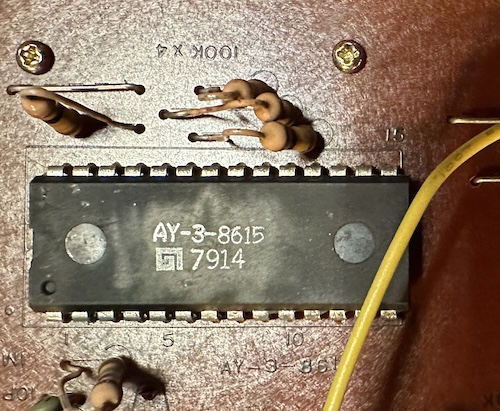
The TV Jack 5000 was succeeded by the Bandai Supervision 8000 (sometimes TV Jack 8000) in 1979. This was a real ROM cartridge based system, combining a Z80 CPU with a Motorola 6847 graphics chip (yes, the same one used in the Tandy Color Computer). Is that one Japan’s first console? Look, just accept it was the Cassette Vision and call it a day, I don’t want another Motorola 6847 in my house.
